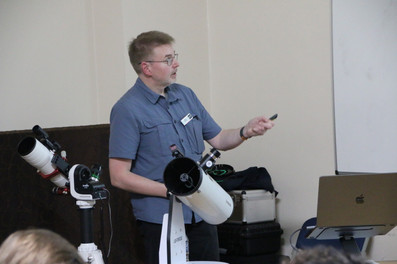Our recent telescope workshop was a resounding success. A massive thank you to all participants, and a special shout-out to our eight dedicated volunteers who generously brought along their equipment for hands-on demonstrations: Clive, Mark, Matthew, Mike, Paul, Richard and Tej; and Bobby for being the “official photographer” for the evening.

For those who missed out, here's a recap:
Telescope 101
Defined by the Oxford English Dictionary, a telescope is an instrument that brings distant objects closer to view. Beyond just magnification, its main goal is to make objects appear bright and detailed, with a touch of contrast.
The Power of Aperture
The diameter of the telescope's objective, or its aperture, is key. The more substantial the aperture, the more light it gathers, allowing us to see more intricate details.
The Magnification Myth
Magnification is a nuanced aspect of telescopic observation. While it might seem like the more you magnify, the better the view, that's not always the case. Often, a lower magnification can offer a clearer, sharper image. It's essential to strike a balance, as excessively high magnification can diminish the quality and brightness of the view, making celestial objects appear less distinct.

Choosing Your Cosmic Companion
Refractors: Utilise lenses. They're known for their contrast and ease of use, though some might show colour discrepancies.
Reflectors: Rely on mirrors. They're value-packed but may need some tender loving care.
Catadioptrics (like Maksutovs and SCTs): A blend of lenses and mirrors. They pack a punch in terms of portability but might come with a heftier price tag.
The Art of Collimation
To get the best out of your telescope, collimation is crucial. It's all about aligning the telescope's optical elements. And while Newtonians and SCTs need regular check-ups, refractors are the easy-going ones in the bunch.

Mounts: Holding the Universe Steady
From the straightforward Alt-Az and the robust Dobsonian to the precise Equatorial, choosing the right mount is essential for that perfect celestial view.
The Tech Touch: “Go-To” Mounts
For those who love a dash of automation, go-to mounts are a dream. Once calibrated, they'll find and follow celestial wonders on their own.
The Next Big Thing: Smart Telescopes
Enter the age of smart telescopes. Innovations by brands like Vaonis and Unistellar, offer real-time deep-sky views, making stargazing more interactive and captivating. Cheaper products like the ZWO SeeStar and Dwarf II Smart Telescope are now entering the market, making this technology accessible to many more people.

Finding Your Perfect Telescope
Your ideal telescope depends on your aspirations. Are you into casual stargazing, detailed imaging, or a bit of both? Whatever it is, remember to factor in size, weight, and upkeep. And if you're on the fence, pop over to one of our observing sessions. Our society is always here to guide you.
In conclusion, the best telescope is the one you'll frequently use. So, pick wisely, gaze often, and keep your cosmic curiosity alive!
Thank you to all attendees for making this workshop a memorable one. Until our next celestial journey with the Flamsteed Astronomy Society! 🌌








































Comments